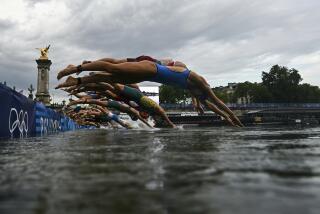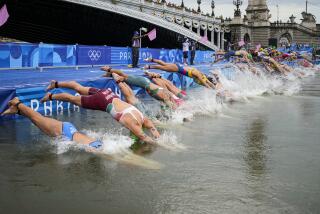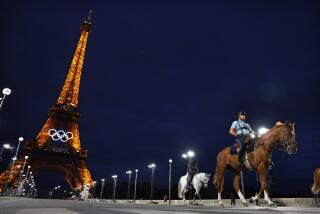Sailing on Seine: Paris Passenger Service Launched
- Share via
PARIS — With a powerful rumble from its twin diesel engines, the 10 a.m. river bus Rhone pulled away from its moorings Monday on the maiden voyage of what city officials hope will become the first regular passenger service along the Seine since 1935.
It was a beautiful clear spring day. Girl scouts sold traditional May 1 bouquets of lilies-of-the-valley on the river banks. Boat pilot Jean-Luc Daled, 28, delighted with his new occupation as river bus driver, expertly guided the 60-foot boat between the bridge pillars and maintained a flowing commentary.
“You have to keep your distance from the bateaux mouches, “ he said, pointing to one of the huge tourist boats with several hundred passengers 50 yards upstream. “You can’t stop one of these things like a car. Still, the traffic is much better down here on the river than it is up on the streets. It’s very relaxed, don’t you think?”
Most of the passengers on this initial voyage were journalists, who busied themselves during the 45-minute round-trip interviewing each other and speaking for French, Japanese, German and Italian television cameras about the joys and beauties of river travel as opposed to the hassles and vulgarities of subway and bus transport.
Curious Tourists
But as the 158-passenger craft made the circuit of five stops between the Eiffel Tower and Paris City Hall, it began to gather a few legitimate fares, mostly curious tourists who had seen the ticket booths and tented passenger shelters along the river.
The passenger boat service will be operated as an experiment until Sept. 30 to test the market, said Jean-Pierre Cuny, director of Bateaux Parisian, the private company that won the contract from the city of Paris and the government ministry in charge of river traffic.
Initially, two batobus --a combination name formed by its French government sponsors from bateau (boat) and autobus-- will run daily routes between 10 a.m. and 8 p.m. Tickets are expensive compared to subway and bus fares--$5 for a single trip compared to 50 cents for a subway ride.
The river ride is also considerably slower. For example, the trip between Port de la Bourdonnais underneath the Eiffel Tower to Quai de Montebello across from Notre Dame Cathedral takes 25 minutes, compared to only three minutes on the underground train that follows the same route.
“The ground transportation system is so good it is hard to beat,” admitted Cuny. However, officials are hoping for a steady flow of tourists, who can also buy cheaper all-day or weekly passes, and Parisians who want relief from the pressures of the city.
Besides, said government spokesman Bertrand Duteil in defense of the batobus, “We may not be as fast as the subway. But we are able to show that the average speed of a city bus is less than 10 kilometers per hour (6 m.p.h.) while the batobus can do 12 kilometers per hour (7 m.p.h.).”
The river bus system has many critics, especially among those who run the bateaux mouches sightseeing boats.
“This is an old file that keeps popping up,” said Michel Bryere, commercial director for one of the larger tourist boat companies. “If the idea of the system is to make a profit from Parisians by taking them to work, then it is not possible.”
The last regular commercial transport system on the Seine, the vaporetto boats that plied the river between Suresnes and the Marne River, went bankrupt in 1935. A recent similar attempt--entitled River Bus--to provide passenger traffic on the Thames in London has suffered financial difficulties.
However, many Parisians remember fondly several weeks in 1972 when subway and train strikes almost brought the city to a standstill. Several of the bateaux mouches operators ran regular routes up and down the river.
“During the strikes of 1972, I carried 7,000 people a day in my boats,” recalled boat operator Jean Brunet. “I’m ready to go again if this proves successful.”
More to Read
Sign up for The Wild
We’ll help you find the best places to hike, bike and run, as well as the perfect silent spots for meditation and yoga.
You may occasionally receive promotional content from the Los Angeles Times.






